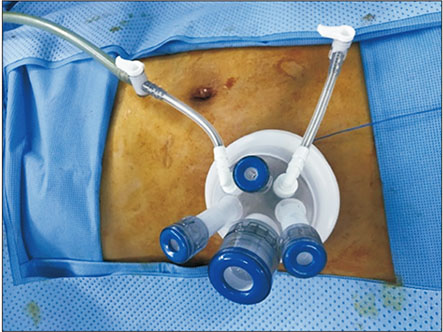Ann Surg Treat Res.
2018 Dec;95(6):319-323. 10.4174/astr.2018.95.6.319.
Single-incision laparoscopic ileostomy is a safe and feasible method of fecal diversion for anastomotic leakage following laparoscopic low anterior resection
- Affiliations
-
- 1Department of Surgery, Incheon St. Mary's Hospital, College of Medicine, The Catholic University of Korea, Incheon, Korea.
- 2Department of Surgery, Seoul St. Mary's Hospital, College of Medicine, The Catholic University of Korea, Seoul, Korea. yslee@catholic.ac.kr
- KMID: 2426763
- DOI: http://doi.org/10.4174/astr.2018.95.6.319
Abstract
- PURPOSE
Currently, many operations are performed using the single-incision laparoscopic method. Although there have been recent reports on single-incision laparoscopic ileostomy, none have compared this method to conventional laparoscopic ileostomy. This study aimed to assess the safety and feasibility of single-incision laparoscopic ileostomy for anastomotic leakage following laparoscopic low anterior resections.
METHODS
From April 2012 to April 2017, 38 patients underwent laparoscopic ileostomy (single-incision; 19 patients referred to as group A, conventional laparoscopy; 19 patients referred to as group B) for anastomotic leakage following laparoscopic low anterior resection. We analyzed surgical and clinical outcomes between the 2 groups. Patients in whom a protective ileostomy was carried out during the initial laparoscopic low anterior resection were excluded from this study.
RESULTS
No significant differences were observed between the 2 groups in terms of patient demographics and initial operation details. Incisional surgical site infections occurred less in group A than in group B (2 of 19 vs. 9 of 19, P = 0.029). The median ileostomy operation time, amount of intraoperative bleeding, parastomal hernia ratio, hospital stay duration after ileostomy, postoperative pain score were not significantly different between the 2 groups.
CONCLUSION
Single-incision laparoscopic ileostomy is safe and feasible method of fecal diversion for anastomotic leakage following laparoscopic low anterior resection.
MeSH Terms
Figure
Reference
-
1. Khoo RE, Montrey J, Cohen MM. Laparoscopic loop ileostomy for temporary fecal diversion. Dis Colon Rectum. 1993; 36:966–968.2. Hollyoak MA, Lumley J, Stitz RW. Laparoscopic stoma formation for faecal diversion. Br J Surg. 1998; 85:226–228.
Article3. Young CJ, Eyers AA, Solomon MJ. Defunctioning of the anorectum: historical controlled study of laparoscopic vs. open procedures. Dis Colon Rectum. 1998; 41:190–194.4. Ahmed K, Wang TT, Patel VM, Nagpal K, Clark J, Ali M, et al. The role of single-incision laparoscopic surgery in abdominal and pelvic surgery: a systematic review. Surg Endosc. 2011; 25:378–396.
Article5. Lim SW, Kim HR, Kim YJ. Single incision laparoscopic colectomy for colorectal cancer: comparison with conventional laparoscopic colectomy. Ann Surg Treat Res. 2014; 87:131–138.
Article6. Waters JA, Guzman MJ, Fajardo AD, Selzer DJ, Wiebke EA, Robb BW, et al. Single-port laparoscopic right hemicolectomy: a safe alternative to conventional laparoscopy. Dis Colon Rectum. 2010; 53:1467–1472.
Article7. Zaghiyan KN, Murrell Z, Fleshner PR. Scarless single-incision laparoscopic loop ileostomy: a novel technique. Dis Colon Rectum. 2011; 54:1542–1546.
Article8. Nguyen HM, Causey MW, Steele SR, Maykel JA. Single-port laparoscopic diverting sigmoid colostomy. Dis Colon Rectum. 2011; 54:1585–1588.
Article9. Heald RJ, Husband EM, Ryall RD. The mesorectum in rectal cancer surgery--the clue to pelvic recurrence? Br J Surg. 1982; 69:613–616.
Article10. Quirke P, Durdey P, Dixon MF, Williams NS. Local recurrence of rectal adenocarcinoma due to inadequate surgical resection. Histopathological study of lateral tumour spread and surgical excision. Lancet. 1986; 2:996–999.11. Wibe A, Eriksen MT, Syse A, Myrvold HE, Soreide O. Norwegian Rectal Cancer Group. Total mesorectal excision for rectal cancer--what can be achieved by a national audit? Colorectal Dis. 2003; 5:471–477.12. Bokey EL, Chapuis PH, Hughes WJ, Koorey SG, Hinder JM, Edwards R. Morbidity, mortality and survival following resection for carcinoma of the rectum at Concord Hospital. Aust N Z J Surg. 1990; 60:253–259.
Article13. Karanjia ND, Corder AP, Bearn P, Heald RJ. Leakage from stapled low anastomosis after total mesorectal excision for carcinoma of the rectum. Br J Surg. 1994; 81:1224–1226.
Article14. Nesbakken A, Nygaard K, Lunde OC. Outcome and late functional results after anastomotic leakage following mesorectal excision for rectal cancer. Br J Surg. 2001; 88:400–404.
Article15. Memon AA, Marks CG. Stapled anastomoses in colorectal surgery: a prospective study. Eur J Surg. 1996; 162:805–810.16. Matthiessen P, Hallbook O, Andersson M, Rutegard J, Sjodahl R. Risk factors for anastomotic leakage after anterior resection of the rectum. Colorectal Dis. 2004; 6:462–469.
Article17. Rahbari NN, Weitz J, Hohenberger W, Heald RJ, Moran B, Ulrich A, et al. Definition and grading of anastomotic leakage following anterior resection of the rectum: a proposal by the International Study Group of Rectal Cancer. Surgery. 2010; 147:339–351.
Article18. Hyman NH. Managing anastomotic leaks from intestinal anastomoses. Surgeon. 2009; 7:31–35.
Article19. Zhu QL, Feng B, Lu AG, Wang ML, Hu WG, Li JW, et al. Laparoscopic low anterior resection for rectal carcinoma: complications and management in 132 consecutive patients. World J Gastroenterol. 2010; 16:4605–4610.
Article20. Williams JZ, Barbul A. Nutrition and wound healing. Surg Clin North Am. 2003; 83:571–596.
Article21. Troppmann C, Pierce JL, Gandhi MM, Gallay BJ, McVicar JP, Perez RV. Higher surgical wound complication rates with sirolimus immunosuppression after kidney transplantation: a matched-pair pilot study. Transplantation. 2003; 76:426–429.
Article22. Scappaticci FA, Fehrenbacher L, Cartwright T, Hainsworth JD, Heim W, Berlin J, et al. Surgical wound healing complications in metastatic colorectal cancer patients treated with bevacizumab. J Surg Oncol. 2005; 91:173–180.
Article
- Full Text Links
- Actions
-
Cited
- CITED
-
- Close
- Share
- Similar articles
-
- Risk Factors for Anastomotic Leakage after Laparoscopic Rectal Resection in Rectal Cancer: Does Laparoscopic Rectal Resection Increase Anastomotic Leakage Rate?
- Safety and Efficacy of Single-Port Laparoscopic Ileostomy in Palliative Settings
- Feasibility of Single-Incision Plus One Port Laparoscopic Low Anterior Resection for Rectal Cancer
- Anastomotic Sinus That Developed From Leakage After a Rectal Cancer Resection: Should We Wait for Closure of the Stoma Until the Complete Resolution of the Sinus?
- Risk Factors for Anastomotic Leakage after Laparoscopic Rectal Resection


